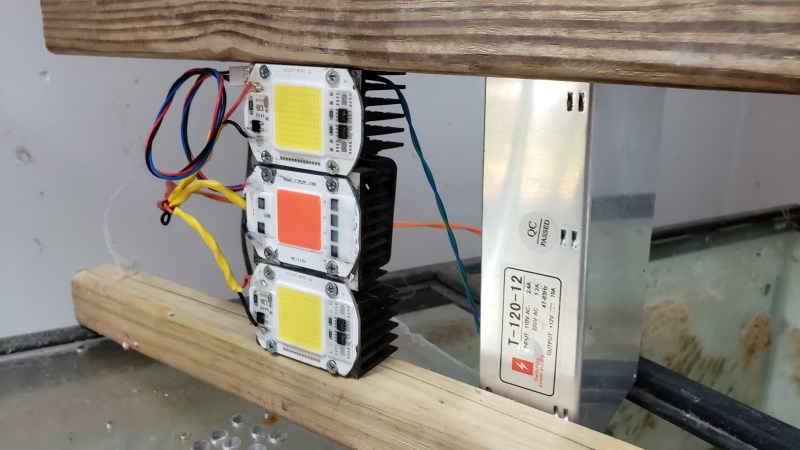[Phillip]’s project is not just great for learning new words, it also shows just how complex natural systems can be.
As we know from news around the word, reefs are delicate systems prone to damage from just about any imaginable threat. Escaped aquarium fish, sunscreen, and the wayward feet of well meaning tourists to name a few. So it’s no wonder that aquarium hobbyists sometimes go to incredible lengths to simulate the natural environments these creatures live in.
While [Phillip] is still tinkering with his designs for this project, we found the data he included really interesting. His goal is to be able to plug in any coordinate on the earth and have the lights replicate the location. That includes not just the sun, but also the light from the moon as many corals seem to only spawn during certain tides. Of course no LED is perfect so he’s even experimenting with putting light sensors under the water to provide a feedback loop to make it perfect.
We really like the ambition of this project and we hope he continues.















should that no say diurnal instead of dinural?
Diurnal – Wikipedia
https://en.wikipedia.org › wiki › Diurnal
Diurnal (“daily”) may refer to: General[edit]. Diurnal cycle, any pattern that recurs daily. Diurnality, the behavior of animals and plants that are active in the daytime
I like the bit where “Great for learning new words” … fails to learn new word :-D
DINURAL? DIUNRAL!
Doh! DIURNAL – Levenshtein distance of 2, not 1
Not sure why punching in new locations easily is desirable, unless you wanna give your clownfish a vacation in the North Sea on Tuesdays.
It’s not about the fish. Certain corals don’t do well unless they have the exact day and night cycle where they are found. This includes the very important lunar cycles. Corals can sense these cycles and will spawn at random intervals throughout the year. The main purpose of home reef keeping is to preserve the specimen and enjoy it’s beauty. Our oceans are becoming inhabitable because of all different reasons, mostly us. The reef community just wants to ensure we save them from extinction since we can’t force the rest of the world to change.
I got that, so why go changing it willy nilly, is it so your new Coral of the Month club pick thrives while last months old news dies off???
Well as far as I know coral isn’t hugely well understood so easy tinkering probably helps find the right conditions for it to thrive and which conditions promote propagation. Also just because a coral came from one location doesn’t mean it won’t actually do better in other conditions – only have to look at invasive species to see how true that can be.
And then there is the most obvious reason to make it easy to set. To remove the barriers to entry for reef keeping, if you have one drop in perfect for all reefs lighting rig that is easy to set up it means nobody else needs to duplicate that work.
Because my reef is different from my neighbor’s reef are different and the easier it to use the easier it is sell/share to him and
Aquarium enthusiasts are close but competitive, while they share alot information, small improvements lead to major bragging points
Besides, should that be a fixed option or just difficult…..
“As one should expect, it is a normal distribution.” This seems unlikely. The insolation is directly proportional to the cosine of the angle of incidence of the sunlight. Being underwater you have to also account for the reflection at the interface of air/water, which is also proportional to the cosine up to the angle of total reflection. A couple coefficients and a cos squared seems more likely if you want to use an overhead source to model the light that actually reaches the critters. I really can’t figure where a normal distribution would come from except that it looks rather like a cos squared. (The same calculation as for the light that reaches a fixed position solar cell with a glass cover. You can use a time parameter instead of an angle in the modeling.)
Are you treating the air/water interface as a plane? It’s usually manifested physical sines with a very variable Z component.
I’m just guessing. I would be surprised if it didn’t average to a plane.
Plus, the source here is not at infinite distance, so some parts of the tank (directly under the source) will get a lot more light than others. It will decrease quite dramatically if the sources is close to the water, and the angle for total reflection will occur fairly close to the source and no light will penetrate the surface beyond that (ends and corner of tank for example).
Putting the light up against the tank on one end might be a lot better.
Yeah, we hope that he continues. Love the projects which are about reef tanks! Because reef stuff costs a lot! I have 2 reef tanks with DIY LEDs, both looks great, especially SPS corals.